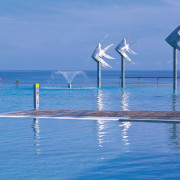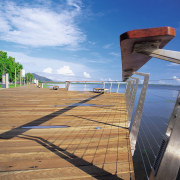City link
The redeveloped Cairns Esplanade has revitalised the CBD and integrated the city with its waterfront

Designing public spaces requires careful consideration, especially when the space is destined to fulfil more than one role.
The Cairns Esplanade was revitalised for dual purposes in a joint venture between Cox Rayner Architects and Tract Landscape Consultants. The two companies won this opportunity in a 1998 national design competition, says architect Michael Rayner.
"The brief included the revitalisation of the CBD and the beautification of what was formerly fairly nondescript use of this space. We also saw it as an opportunity to link the greater waterfront area, including the city port, to provide a focus for Cairns," he says.
Cox Rayner was also given the job of redesigning 2km of land along Trinity Inlet. This meant the company could instigate a broader masterplan for the entire area.
The Cairns Esplanade, with its lagoon and recreational park, is one of four nodes of the new waterfront, says Rayner. Other parts include new wharves and a public square. A new terminal for boats departing to the Great Barrier Reef better portrays Cairns as the gateway to this popular destination.
"Our concept for the Esplanade was to give the area a very urban treatment and create an obvious link to the city," says Rayner.
The angular forms of the structures, and the materials used, relate to the city, while the most organic aspects of the design are the numerous artworks, he says.

"The lagoon, with its strong geometric lines, differs from other, more organic, urban initiatives like the Southbank in Brisbane. The Cairns Espalanade provides a recreational area, but was conceived with a geometric approach, to create an architectural relationship with the city," he says.
The lagoon is surrounded by timber decking, covered in some parts by sunshades. Other angle-roofed structures provide shelter and also act as information pavilions.
These information pavilions, designed by Peddle Thorpe Architects, are paired in three groups that represent cultural, historic and environmental themes.
Originally, the Cairns Esplanade consisted of mudflats. Swimming wasn't an option unless you went to the reef, says Rayner.
"Because of the mudflats we had to use a considerable amount of landfill. We raised the level by about two metres, then we waited and watched for three years, until it had subsided enough to be developed," he says.
Rayner says tourists to Cairns often expected white sandy beaches, but instead they found mudflats and mangroves. Developing the lagoon means tourists stay in the city for longer, and this has associated economic benefits.
Access to the Esplanade was improved by extending the main street as a pedestrian-only boulevard.

"Now when you are in the city you can stand on Shields Street and see a water-on-water view," says Raynor.
The lagoon holds 4000m² of water, which bleeds into the sea via a wet edge. This creates the impression that water comes into the city's front door.
A timber walkway on the sea edge of the lagoon accentuates this illusion by creating the impression that people are walking on water.
To prevent the lagoon water becoming stagnant, it goes through a recirculation plant. The plant, housed in a large building clad in coloured panels, needed to contribute to the recreational atmosphere of the area, says Rayner.
Original plans to house the whole plant under ground were reconsidered because of large costs.
The other two buildings on the Esplanade house amenities and a police kiosk. As the lagoon can't be closed like a regular swimming pool, it was necessary to keep views as open as possible, says Rayner.
Credit list
Architect
Construction company
Mechanical and electrical engineer
Lighting consultant
Irrigation consultant
Lagoon safety consultant
Artists
Tiles and paving
Joinery
Story by: Trendsideas
Home kitchen bathroom commercial design
Diving into nature
Classic looks, contemporary efficiency
Personality plus











